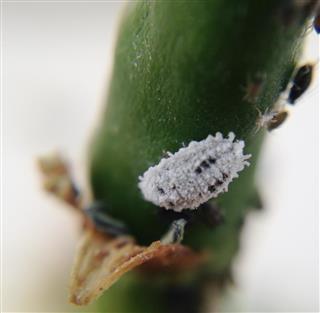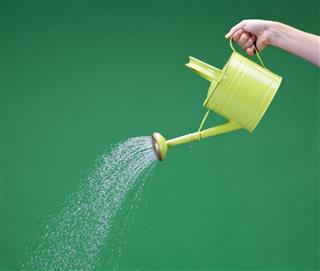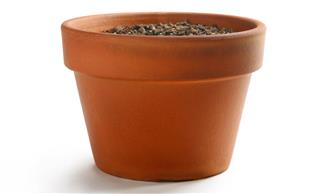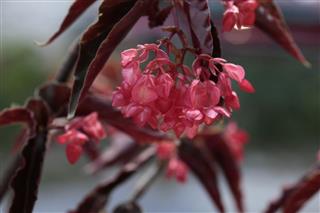
Flowering plants and houseplants can be very easy to look-after (like the aloe vera) or quite difficult (orchids, bonsai). Below, learn how to care for an exotic and colorful member of the Begonia plant genus, the Angel Wing Begonia.
The Begonia genus of flowering plants is a tropical perennial plant species, known for its picturesque blooms and uniquely shaped leaves. A striking hybrid cultivar of this genus is the Angel Wing Begonia. While members of the Begonia species have asymmetrically shaped leaves, this Begonia has fold, jagged-edge, wide leaves that are sprinkled with specks and dots or banded and splotched in a variety of colors. The shape of these leaves is likened to an angel’s wings, hence the name conferred upon this Begonia. The vivid and vibrant look of this plant is enhanced by its clustered, heavy, brightly colored flower bunches, in orange, salmon pink, white and red colors. The Angel Wing Begonia can be grown outdoors or grown in a pot and kept as a houseplant. It will bloom all year-round and make very easy-to-maintain houseplants.
Angel Wing Begonia Care Guide
Soil
The soil profile for Angel Wing Begonia plants is light, quick-draining and airy soil, that is peaty and has mild or no acidity. The soil should be rich in nutrients and remain moist but drain water quickly. Place pebbles at the bottom of the pot to increase the rate of water drainage. When planting, do not pack the soil around the roots firmly, try to keep it airy by tapping it gently with your fingers.
This Begonia has a large diameter and heavy flowers and roots. Hence it needs a sturdy pot or container, made of a heavy material like ceramic, clay or thick plastic, so the pot will not tip over with the weight of the plant. This plant will reach a height of 15 to 18 inches at maturity, and requires a pot size of 6-8 inches. Larger begonias will need a 10-12 inch pot as they grow. In spring, you should repot your plant to a larger pot for optimal growth.
Light
The Angel Wing Begonia needs a lot of natural light to thrive and flourish. Both the quantity and quality of its flowers, as well as the color and shine of its leaves, depend heavily on sunlight. But the light should not be direct and harsh. Indirect or filtered light through a window or screen is best for this delicate begonia. Light and partial shade are also suitable. This Begonia should receive light year-round. During autumn and winter, when sunlight is less and lacking in intensity, you can place the Begonia in direct sunlight for a few hours.
For a bright, blooming and vibrantly colored Begonia, place the pot or container near windows or screen doors during the early morning or afternoon hours. Sunrooms, with sunlight streaming in through the windows and their humid temperature, are the best site to place this Begonia specimen. If the plant seems to grow length or width-wise, with elongated stems and leaves but will not bloom, it is receiving inadequate light. On the other hand, curled and brownish leaves or burnt leaves are a sign of very strong sunlight falling on the plant.
Water
This Begonia plant needs a lot of water but the soil should be allowed to drain between successive watering. Water your Begonia only when 1 inch of the soil’s surface, in the pot or the garden bed, is dry. Deep watering, two or three times per week is sufficient. Water the complete soil in the pot. The water should drain out of the holes at the bottom of the pot. Do not let water collect in the drip tray, it can cause the roots to rot. Too much water will turn the leaves of the plant yellow, and will also encourage shedding.
Once in a while, enrich the growing soil of the plant with balanced nutrients, fertilizer pellets or granules or compost. In spring and summer, you can apply liquid fertilizer every 2 weeks. If the plant is growing actively, then feed it fertilizer every month and if inactive, feed it once in 2 months.
Temperature
This type of Begonia is a tropical plant and requires a humid and moist atmosphere to grow. The ideal temperature range is 65 – 75 ºF or 18 – 24 ºC. If the temperature drops below 50 ºF, the Begonia might be harmed by the decrease in temperature. Angel Wings are also sensitive to sudden changes in temperature. Hence, be careful not to place a potted Angel Wing near heater vents or AC ducts or drafty locations indoors. Place these plants in an optimal location for air circulation. They will grow in USDA Hardy Zones 10a, 10b and 11.
Pruning
Pruning encourages new growth on the plant and helps shape the plant. Angel Wing Begonias look their best when they grow in diameter, spreading out their blooms and leaves. The number of leaves and blooms should look proportionate. Too many leaves and less blooms indicate the plant needs more sunshine. If the plant starts to look “leggy” (thin and weak but tall), then prune off the stems at various lengths. To get a rounded shape, start from the plant’s center and top and trim the stems in long, short and medium lengths. Work your way towards the bottom of the plant. If the stems of the plant are especially elongated and the blooms tip over and droop, then stake some stems at a slight height.
You can trim back the stems on this plant regularly to control its growth. When the plant reaches a height of 6 inches, hand pinch the top growing shoot to encourage branching. When the plant is one-year old, then trim it down to a height of 6 inches in the winter and once again in late spring. And the stem cuttings will not go to waste either, as they can be used very easily to propagate the plant. Angel Wing Begonia cuttings taken from the stem, should be rooted in a small pot of moist sand or perlite.
Pests
The Angel Wing Begonia is a favorite leafy target for insect pests like whiteflies and mealybugs. If the leaves of the plant do not have space between them or there is no air circulation, then bacterial infections set in, in the form of yellow rings on the leaves. This is called leaf spot. You can cut off the infected leaves and make sure there is plenty of air circulation for the plant to breathe. The Angel Wing Begonia can also be infected by gray mold and mildew.
From the above factors, one can make out how low-maintenance this plant really is. This hybrid was formed from breeding two distinct plant species, a Begonia aconitifolia and a Begonia coccinea. There are many sub-cultivars of the Angel Wing Begonia, such as the ‘Silver Wings’. So try growing your own variant Angel Wing Begonia to add a unique type of plant to your garden.



